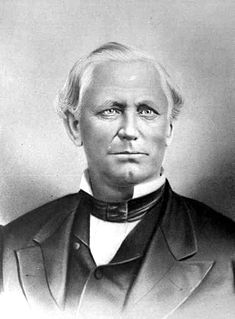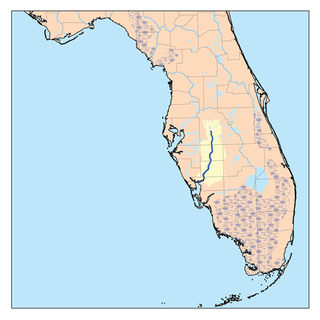Related Research Articles

Polk County is located in the central portion of the U.S. state of Florida. The county population was 725,046, as of the 2020 census. Its county seat is Bartow, and its largest city is Lakeland.

Fort Meade is a city in Polk County, Florida, United States. As of 2018, the population recorded by the U.S. Census Bureau is 6,203. It is part of the Lakeland–Winter Haven Metropolitan Statistical Area. The city was named for George Meade, at the time an Army lieutenant serving in Florida following the Second Seminole War. Fort Meade is home to Fort Meade Middle-Senior High School, several historic buildings, Streamsong resort and Patterson Park. The area is popular with kayakers and canoers.
The history of Florida can be traced to when the first Native Americans began to inhabit the peninsula as early as 14,000 years ago. They left behind artifacts and archeological evidence. Florida's written history begins with the arrival of Europeans; the Spanish explorer Juan Ponce de León in 1513 made the first textual records. The state received its name from that conquistador, who called the peninsula La Pascua Florida in recognition of the verdant landscape and because it was the Easter season, which the Spaniards called Pascua Florida.

William Dunnington Bloxham was the 13th and 17th Governor of Florida in two non-consecutive terms. Prior to his first term as governor, he served in the Florida House of Representatives.

David Shelby Walker was the eighth Governor of Florida, serving from 1866 to 1868.

Ossian Bingley Hart was the tenth Governor of the U.S. state of Florida, and the first governor of Florida who was born in the state. Born in Jacksonville to Isaiah Hart, one of the city's founders, he was raised on his father's plantation along the St. Johns River. He was a lawyer in Jacksonville. He moved to a farm near Fort Pierce, Florida in 1843, and was a founding member of the St. Lucie County Board of Commissioners. In 1845, Hart became Florida State Representative for St. Lucie County. In 1846 he moved to Key West where he resumed his law practice. In 1856, he moved to Tampa, Florida. Among his clients was "Adam", a black man who was lynched after the Florida Supreme Court declared his murder conviction a mistrial.

Jonathan Clarkson Gibbs, II was an American Presbyterian minister who served as Secretary of State and Superintendent of Public Instruction of Florida, and along with Josiah Thomas Walls, U.S. Congressman from Florida, was among the most powerful black officeholders in the state during Reconstruction. An African-American who served during the Reconstruction era he was the first and so far only black Florida Secretary of State.

The Peace River is a river in the southwestern part of the Florida peninsula, in the U.S.A.. It originates at the juncture of Saddle Creek and Peace Creek northeast of Bartow in Polk County and flows south through Fort Meade Hardee County to Arcadia in DeSoto County and then southwest into the Charlotte Harbor estuary at Punta Gorda in Charlotte County. It is 106 miles (171 km) long and has a drainage basin of 1,367 square miles (3,540 km2). U.S. Highway 17 runs near and somewhat parallel to the river for much of its course. The river was called Rio de la Paz on 16th century Spanish charts. It appeared as Peas Creek or Pease Creek on later maps. The Creek Indians call it Talakchopcohatchee, River of Long Peas. Other cities along the Peace River include Fort Meade, Wauchula and Zolfo Springs.
Isaiah David Hart was an American plantation owner, and the founder of Jacksonville, Florida. Originally from Georgia, Hart took up arms against Spain in the Patriot Rebellion of 1812. After moving to a location near the cow ford on the narrows of the St. Johns River, he began platting the town in 1822, and later served as postmaster, court clerk, commissioner of pilotage, judge of elections, major in the local militia during the Seminole War, and as a Whig member of the Florida Territorial Senate. The Isaiah D. Hart Bridge over the St. Johns River in Jacksonville is named after him.

Thomas Baltzell was an American lawyer and politician who was the first popularly elected chief justice of the Florida Supreme Court. Baltzell was also a Florida Territory Senator and a Florida State Representative as well as a Florida Constitutional Convention delegate for two of the state's Constitutions.

Joseph Bradford Lancaster was an American lawyer and Whig politician who served on the Florida Supreme Court from 1848 to 1850. An important figure in Florida law and politics, he was the last justice under the system in which the circuit court judges served also on the supreme court and served as Mayor of Jacksonville, Florida from 1846–1847 and as the first Mayor of Tampa, Florida in 1856.
Franklin D. Fraser was a Florida lawyer and a Republican politician who served on the Florida Supreme Court from 1873 to 1874.

Charles H. Pearce (1817–1887) was a religious and political leader in Florida. An African Methodist Episcopal (AME) minister, he was dispatched to Florida in 1865, after the American Civil War. He had previously been a missionary in Canada after moving from Maryland to Connecticut. He helped bring the AME Church, the first independent black denomination in the United States, to Florida and worked to build its congregation during and after the Reconstruction era. In 1868 Pearce was elected as a delegate to the Florida Constitutional Convention of 1868. Later that year he was elected to the state legislature as a state senator from Leon County, Florida. He served numerous terms in the legislature, working to gain support for civil rights and public education for Floridians.
James T. Magbee, known as J. T. Magbee, was a pioneer of Tampa, Florida, the town's first lawyer, and the federal collector of revenues at Tampa. Magbee was a Florida State Constitutional Convention delegate, a Florida State Senator, a newspaper editor and a judge of the Circuit Court. He owned slaves prior to the Civil War.
Dr. Algernon Sidney Speer was a Florida settler and politician, serving as House of Representative for Orange County, Florida in the Florida State Legislature from 1854-1855. Before his political career, he was also a lawyer, horticulturist, farmer. The place Speer's Landing carries his namesake.
Angola was a prosperous community of up to 750 maroons that existed in Florida from 1812 until Florida became a U.S. territory in 1821, at which point it was destroyed. The location was along the Manatee River in Bradenton, Florida, near Manatee Mineral Springs Park. The exact location is expansive, ranging from where the Braden River meets the Manatee River down to Sarasota Bay; archaeological research focuses on the Manatee Mineral Spring—a source of fresh water and later the location of the Village of Manatee two decades after the destruction of the maroon community. Archaeological evidence has been found and the archaeology report by Uzi Baram is on file with the Florida Division of Historical Resources of the Florida Department of State.

James Gettis was a lawyer and judge in Tampa, Florida. He was the second lawyer in Tampa. Gettis was also a city councilman, and state representative, and the first town clerk.

William Archer Cocke was an American attorney and politician who served as the 13th Florida Attorney General. Cocke was placed into the national spotlight due to his role in the controversy following the 1876 presidential election.
William Bradwell was a religious leader and Reconstruction era politician in Florida. He lived in Jacksonville and represented Duval County in the Florida Legislature. An African American, he was a leader in the A.M.E. Church. He served in the Florida Senate representing Duval County, Florida from 1868 to 1870. He was a Republican amd stated that his father was "one of the first representatives to the Legislature of Georgia".
Larry Eugene Rivers is a college president, history professor, and author in the U.S.
References
- ↑ "2 Aug 1998, 80 - The Tampa Tribune at Newspapers.com". Newspapers.com.
- ↑ "Political history of blacks fills pages".
- ↑ Canter Brown, Jr. Archived May 30, 2010, at the Wayback Machine Center for Florida History
- ↑ Coles, David J.; Brown, Canter (2001). "Reviewed work: Tampa in the Civil War and Reconstruction, Canter Brown, Jr". The Georgia Historical Quarterly. 85 (2): 317–319. JSTOR 40584427.